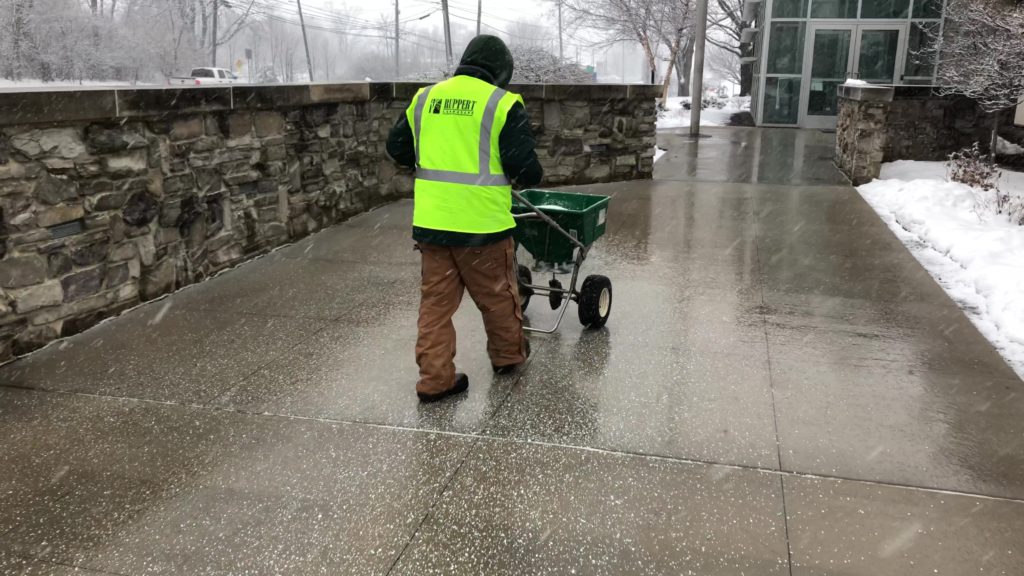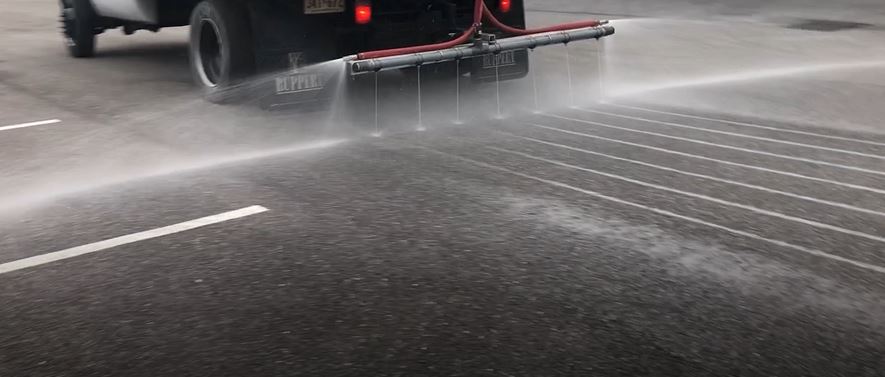 By Josh Nichols, Regional Snow Manager
By Josh Nichols, Regional Snow Manager
When it comes to winter weather, having a solid game plan in place is critical. Our crews not only perform snow removal but take proactive steps to prevent and minimize the effects of snow and ice on our clients’ properties. Understanding the difference between anti-icing and de-icing is an important first step in the process:
- Anti-icing is intended to prevent a strong bond between frozen precipitation or frost and a pavement surface by timely application of a chemical freezing point depressant.
- De-icing is a when a de-icer is applied to the top of an accumulation of snow, ice, or frost that is already bonded or formed to the pavement surface.
The major benefit of anti-icing is that it breaks the initial bond of snow and ice to the pavement. This will ultimately provide a cleaner clearing of the surfaces and will require less materials in the de-icing process. In some instances, the anti-icing treatment is all that’s required. When anti-icing is not performed, snow will bond to surfaces and clearing will require more time and effort. In addition, it will require more de-icing material to get to clear surfaces. Not every storm should be treated with an anti-icing application, but when done, typically delivers the best results and helps manage overall costs, providing a better final product.
There are several factors that we consider when deciding the correct course of action:
- Air temperature
- Pavement temperature
- Type of precipitation
- Type of surface (asphalt or concrete)
- Wind speed & direction
Both methods of ice control can be accomplished using traditional granular materials or a liquid solution. There is a wide variety of products available, each with different benefits and cost points.
Granular Materials
 Using a granular application method should typically occur closer to the start of the event. This will prevent unnecessary tracking or displacement of the material from vehicles and pedestrian foot traffic. Types of granular materials include:
Using a granular application method should typically occur closer to the start of the event. This will prevent unnecessary tracking or displacement of the material from vehicles and pedestrian foot traffic. Types of granular materials include:
- Sodium Chloride – Also known as rock salt, this is one of the most commonly used ice melt products and is used on roadways and parking lots.
- Calcium Chloride – Commonly used on sidewalks and parking garages. It’s effective to much lower temperatures than salt. If over-applied, it can create a slippery surface due to its exothermic characteristics. Exothermic refers to a chemical reaction that releases energy in the form of heat, light, or sound.
- Magnesium Chloride – Commonly used on sidewalks and parking garages. It’s effective to lower temperatures than salt, but not as low as calcium chloride. If over-applied, it too, can create a slippery surface due to its exothermic characteristics.
- Blended Ice Melt – Commonly used on sidewalks. This is a sodium chloride blend that is usually treated with a liquid magnesium or calcium chloride that help work at lower temperatures and accelerate the melting process. Some blends incorporate granular calcium and magnesium as opposed to the liquid.
Liquid Materials
One benefit with a liquid application is that it can be applied 48 hours in advance of the storm. It also doesn’t create a messy situation if the forecasted event does not materialize. Types of liquid solutions include:
 Sodium Chloride – This is a liquid form of rock salt created by mixing water with rock salt and is commonly used to treat roadways and parking lots.
Sodium Chloride – This is a liquid form of rock salt created by mixing water with rock salt and is commonly used to treat roadways and parking lots.- Sodium Chloride Blend – This is a liquid form of rock salt that is enhanced by adding other types of de-icing agents, the most common of which are calcium or magnesium chloride. Other types of additives are agricultural byproducts that help lower melting temperature and/or provide some type of additional corrosion inhibitors. These blends can be custom made depending on the storm and the expected temperatures.
Selecting the right approach for each storm is a science and can vary greatly on a storm-by-storm basis. No two storms are the same, nor is the same storm similar in a different location across town. We educate our teams on the latest products, equipment and techniques to make sure our snow tool bag has plenty of options when it comes to attacking a winter weather event. Applying a scientific approach to material applications will allow for the best approach, which ultimately provides a safer environment for tenants and customers.
The type of material and application that we choose depends on the weather and surface conditions, as well as our clients’ preference and budget. If you are interested in adding anti-icing or de-icing treatments to your snow contract, reach out to your field manager or area manager, or contact me at jnichols@ruppertcompanies.com for more information.
 By Josh Nichols, Regional Snow Manager
By Josh Nichols, Regional Snow Manager Sodium Chloride – This is a liquid form of rock salt created by mixing water with rock salt and is commonly used to treat roadways and parking lots.
Sodium Chloride – This is a liquid form of rock salt created by mixing water with rock salt and is commonly used to treat roadways and parking lots.